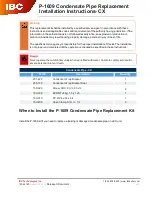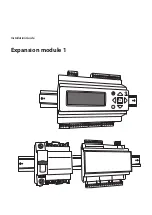
Innovation Hot Water Hot Water Boiler User Manual
- INTERNATIONAL
CHAPTER 4 – INITIAL START-UP
Page
56
of
174
AERCO International, Inc.
•
100 Oritani Dr.
•
Blauvelt, NY 10913
OMM-0120_0A
11/15/2016
Phone: 800-526-0288
GF-128-I
4.4 REASSEMBLY
Once the combustion calibration adjustments are properly set, the unit can be reassembled for
service operation.
Reassembly
1.
Set the ON/OFF switch in the
OFF
position.
2.
Disconnect AC power from the unit.
3.
Shut off the gas supply to the unit.
4.
Remove the manometer and barbed fittings and reinstall the NPT plug using a suitable pipe
thread compound.
5.
Remove the combustion analyzer probe from the 1/8” (3.18 mm) vent hole in the exhaust
manifold. Replace the 1/8” NPT plug in the manifold.
6.
Replace the unit’s side panels and front door.
4.5 TEMPERATURE CONTROL CALIBRATION
Carefully follow the procedures below to properly set up the temperature control for the heater.
Ignoring this commissioning step may cause water temperature faults, poor water temperature
control, and rapid cycling of the heater.
The unit normally comes factory set and calibrated for a 130°F (54.4°C) setpoint (default value).
However, if a different setpoint temperature is desired, it can be changed using the procedure in
section 4.6.1. If the setpoint is changed, it must be done prior to temperature control calibration.
There are two primary adjustments for performing temperature calibration: Min Load Adj and Max
Load Adj (minimum and maximum load adjustment). Adjustments to these settings are made at
minimum and maximum load conditions and should be made in small increments, from 1 to 3
degrees F (0.55 to 1.65 degrees C). After making an adjustment, the outlet water temperature
must be allowed to settle for several minutes prior to making any further adjustments.
When calibrating temperature control, observe the following:
Temperature Control Calibration
1.
The unit must be in the Auto mode of operation.
2.
The Outlet Feedback option in the Tuning Menu must be set to
DISABLED
while
performing calibration.
3.
Monitor the OUTLET TEMPERATURE display and VALVE POSITION bar-graph to set load
conditions and observe the effect of adjustments.
4.
Perform the calibration using the Tuning Menu of the C-More Control Box.
5.
Make small adjustments and allow time between adjustments for the outlet water
temperature to stabilize.
6.
Maintain water flow as constant as possible during these adjustments.
7.
Ensure that recirculation loops are operational while the calibration is being performed.
8.
Upon completion of calibration, set the Outlet Feedback back to
ENABLE
.
Temperature control calibration is accomplished by performing the Minimum and Maximum Load
Adjustment procedures in sections 4.6.2 and 4.6.3, respectively.
















































